J-103Chapter J:<strong>THE</strong> TUNGUSKA <strong>EXPLOSION</strong> ON 30 JUNE 1908At 7:17 AM on the morning of 30 June 1908, a cylindrical object was observed bynumerous eye witnesses blazing westward across the cloudless skies of the CentralSiberian Plateau near the Stony Tunguska River. The object then exploded withcataclysmic force, 113 kilometres north of the small trade station Vanavara, at the point withgeographical co-ordiantes 60 55'N, 101 57'E. The explosion devastated around 2150square kilometres of native taiga forest, felling trees sometimes up to 75 kilometres distantfrom the centre of the explosion. All these felled trees were lying parallel to each other, withtheir trunks pointing in the centre of the explosion. The whole devastation area formed anunique "butterfly" pattern - pointing magnetic south, similar to the pattern from the Tapanuiexplosion - see Figure C6.Descriptions of events and evidence from the Tunguska explosion are contained innumerous books entirely dedicated to this catastrophe. To supplement the deductionsprovided in this subsection, the author would like to recommend reading some of thesepublications, especially the book [1J] by Jack Stoneley: "Tunguska: Cauldron of Hell" (AStar Book, London 1977, ISBN 0-352-39619-9), and the book [2J] by John Baxter &Thomas Atkins: "The Fire Came By" (MacDonald and <strong>Jan</strong>e's, London 1976, ISBN0-354-04012-X). A summary of the Tunguska explosion can also be found in booksdedicated to other subjects, e.g. in the book [3J] by Ronald D. Story (editor): "TheEncyclopedia of UFOs" (New English Library, London 1980, ISBN 0-450-04118-2) page371. The following quotation from the book [4J] by Nogel Blundell and Roger Boar: "TheWorld's Greatest UFO Mysteries" (Octopus Books Limited, London 1983, ISBN0-7064-1770-4, page 78) gives a brief idea as to what actually happened:"It was just after dawn when the fireball was first spotted. Caravans winding their wayacross China's Gobi Desert stopped to watch it across the skies. Soon people in southernRussia picked it up, a cylindrical tube shape, glowing bluish-white, leaving a multicoloredvapour trail. It was getting lower all the time. Then at 7:17 AM came the explosion. To thepeasants of the sparsely-populated area of swamps and forests, it seemed like the end ofthe world."Initially the Tunguska Blast was attributed to a gigantic meteorite plunging from theheavens. Neither the physical evidence available at the site, or the testimony of eyewitnesses matched the course of events expected for this cause. Then a number of other"natural" explanations were proposed (e.g. a comet, cluster of antimatter, black hole, etc.).But again - none of them matched the existing evidence. Starting from 1946 Soviet scientist<strong>Dr</strong> Aleksander Kazantsev, and a group of his followers, gradually accumulated theconclusive system of evidence that the event previously called the Tunguska Meteorite wasin fact a technological explosion of a large spaceship ([1J], page 119).This conclusion of Russian scientists, that the Tunguska blast was producedtechnologically by an exploding spaceship, is shared by the author in this monograph.However, there is a vital difference between the Russian claim, and the author's hypothesispresented in this monograph. The difference concerns the type of spaceship that explodedin Tunguska. Russians claim that it was a conventional "rocket-type" vehicle propelled bysome kind of a nuclear or antimatter fuel. The author reasons that it was a Magnocraft-typevehicle (UFO) propelled by a pulsating magnetic field. Thus an explosion caused by theauthor's vehicle must have a magnetic nature, which (1) would leave a characteristicdestruction pattern explained in subsection F4, and which (2) would not produce radioactivepollution. On the other hand, for a rocket-type spacecraft as claimed by Russians, the
J-104explosion energy carrier would be the vehicle's fuel, i.e. most probably nuclear isotopes.Thus, such a rocket-type vehicle would produce a destruction pattern differing from thatformed by the Magnocraft, and also it would pollute the environment with radioactivity. Infact, almost all of the evidence presented in the next subsection certifies the correctness ofthe author's hypothesis, simultaneously contradicting the Russian claim that a rocket-typespacecraft exploded there.J1. Parallels between the Tapanui and the Tunguska ExplosionsThere exists astonishing similarities between the Tunguska Blast site and theTapanui Crater. These indicate that the causes of both explosions were the same.Presented below is some evidence originating from the Tunguska blast site which confirmsthe similarities between both explosions (the list of this evidence is combined in the order ofitems from subsection F4, i.e. in the same order in which the attributes of the Magnocraftexplosion sites were presented). While reviewing the descriptions that follow it could bebeneficial to simultaneously compare them with the corresponding items from chapter Hwhich relate to the Tapanui explosion.#1. The energy yields of the Tapanui Crater and the Tunguska Blast are very similar.The yield of the Tunguska Blast is estimated at about 30 megatons of TNT. In comparison,the atomic bomb exploded over Hiroshima had a yield of "only" about 12.5 kilotons (see thebook [5J1] by <strong>Dr</strong>. C. Phillips & <strong>Dr</strong>. I. Ross, "The Nuclear Casebook", ISBN 0-904919-83-8,page 10). It means that over Tunguska an equivalent of 2,400 bombs similar to theHiroshima one exploded. This total energy was released before the object hit the ground.No material object can produce such a vast amount of energy solely because of friction withthe atmosphere. But if a release of the energy contained in the Oscillatory Chambers of theMagnocraft-like spaceship is considered to be the cause for the Tunguska Blast, then onlythree of the K6 type vehicles, joined into a cigar-shaped flying complex, would produce a 30megaton explosion.#2. Both sites are devastated in a manner distinctive for an explosion, not for animpact of a heavenly object. Whenever a heavenly body has hit Earth, it has left a distinctcrater - see Figures C4 and C5. Experts claim that a blast caused by a black hole hittingEarth from space must leave a crater as well (apart from that the black hole would need tocause a similar explosion occurring on the other side of Earth - no such explosion wasregistered at that time in the Atlantic Ocean). But in the Tunguska Blast there was no craterleft at all. Moreover, in the exact centre of the explosion trees were still standing, afterlosing their foliage and branches, though for miles around all the trees had been blownaway. Trees left standing in the centre are also characteristic of a mid-air nuclear explosion.At Hiroshima, for example, trees directly under the blast still stood, while those at an angleto it were flattened. The above proves that the impact of the Tunguska explosion originatedfrom the explosive energy carried on board of the object, not from the kinetic energy of themotion and impact of this object.One of the most astonishing parallels between the Tunguska Site and the TapanuiCrater is the similarity in geometry in internal configuration of both these sites. Thissimilarity is illustrated in Figure C6. Notice that there is a number of geometric featureswhich are repeated in both sites.#3. In both explosions there is evidence documenting a sequence of detonations. InTunguska numerous witnesses reported hearing a sequence of 3 series of detonations (nota single "bang") resembling three packs of petards being fired. Each of these three serieswas composed of many individual bangs similar to those from a battery of artillery guns.Various eye-witnesses who served in artillery and were familiar with similar cannonadeestimated that the total number of explosions in all three series was about 50 to 60 ([1J],page 23). At this point it should be indicated that this kind of acoustic effects would be
- Page 1 and 2:
Proof Copy ([5e/3] reformatted to P
- Page 3 and 4:
3G-83 G. Evidence certifying that M
- Page 5 and 6:
5Notes:(1) Before this monograph wa
- Page 7 and 8:
A-2or disk"). The information which
- Page 9 and 10:
A-4immune deficiency, thus it is qu
- Page 11 and 12:
A-6edition, 1986) even tries to arg
- Page 13 and 14:
A-8changes have no connection with
- Page 15 and 16:
A-10Fig. A2. The curved slope in th
- Page 17 and 18:
B-12inspired me to suspect that hum
- Page 19 and 20:
B-14Earth by evil UFOnauts God trie
- Page 21 and 22:
C-16#10. The spread, radiating from
- Page 23 and 24:
C-18"Te Ura-a-Te Raki-Tamau", which
- Page 25 and 26:
C-20item #2 that follows). Thus, in
- Page 27 and 28:
C-22comparative data which reflects
- Page 29 and 30:
C-24exploding fires, columns of fir
- Page 31 and 32:
C-26banks of the Black Gully Creek,
- Page 33 and 34:
C-28meditating, conducting healing
- Page 35 and 36:
C-30deaths of people with symptoms
- Page 37 and 38:
C-32(1) The Kawakawa volcano erupte
- Page 39 and 40:
C-34The Tapanui Crater is the centr
- Page 41 and 42:
C-36Fig. C2. The inner topography o
- Page 43 and 44:
C-38(a)(d)(b)(c)(e)Fig. C4. Example
- Page 45 and 46:
C-40Fig. C6. The illustration of si
- Page 47 and 48:
C-42Fig. C8. The distribution of in
- Page 49 and 50:
C-44Fig. C10. Two photographs of a
- Page 51 and 52:
C-46Fig. C12. The location of near-
- Page 53 and 54:
C-48Fig. C14. A magnetized metallic
- Page 55 and 56:
D-50Chapter D:EVIDENCE THAT THE TAP
- Page 57 and 58: D-52including Mediterranean and Biz
- Page 59 and 60: D-54rapidly released by this explos
- Page 61 and 62: D-56experiments, and many more. Thi
- Page 63 and 64: D-58that people were in medieval ti
- Page 65 and 66: D-60then continually resonates in t
- Page 67 and 68: D-62"tapanui.htm") are to be met, s
- Page 69 and 70: D-64when such abnormalities of the
- Page 71 and 72: E-66Chapter E.HYPOTHESES EXPLAINING
- Page 73 and 74: E-68is directed towards the magneti
- Page 75 and 76: F-70publication of this design and
- Page 77 and 78: F-72can be built, each type taking
- Page 79 and 80: F-74sites an explosive growth of mu
- Page 81 and 82: F-76F4. Explosion sites of the Magn
- Page 83 and 84: F-78- Deficiency of some sensitive
- Page 85 and 86: F-80(a)…(b)…(c)Fig. F2. The des
- Page 87 and 88: F-82Fig. F4. The explanation for a
- Page 89 and 90: G-84The formal proof that "UFOs are
- Page 91 and 92: G-86civilization(s) sending UFOs mu
- Page 93 and 94: G-88the close proximity of the Tapa
- Page 95 and 96: G-90(c)(d)Fig. G1. Two photographs
- Page 97 and 98: G-92(a)(c)(b)(d)(e)Fig. G3. A spher
- Page 99 and 100: G-94(a)(b)(c)(d)Fig. G5. Pulsating
- Page 101 and 102: G-96(a)(b)(c)(d)(e)Fig. G7. Smooth,
- Page 103 and 104: G-98(a)(b)(c)(d)Fig. G9. Photograph
- Page 105 and 106: H-100#6. The Tapanui Crater is orie
- Page 107: I-102Chapter I:MORAL ACCENTUATION O
- Page 111 and 112: J-106detonation a number of appropr
- Page 113 and 114: J-108resembled "china stones" from
- Page 115 and 116: K-110Chapter K:AROUND 13 500 YEARS-
- Page 117 and 118: K-112civilisation were prepared for
- Page 119 and 120: L-114Chapter L:STILL ANOTHER UFO EX
- Page 121 and 122: L-116Coincidentally, the author had
- Page 123 and 124: M-118in section D3). This in turn h
- Page 125 and 126: N-120Chapter N:TWELVE TRUTHS ABOUT
- Page 127 and 128: N-122only factors which may cause t
- Page 129 and 130: N-124ones who stand by truth and th
- Page 131 and 132: O-126Chapter O:ACADEMIC ASPECTS OF
- Page 133 and 134: O-128Galactic field, thus producing
- Page 135 and 136: O-130specifically what was wrong wi
- Page 137 and 138: O-132moral field causes that we acc
- Page 139 and 140: O-134white glowing balls of playful
- Page 141 and 142: O-136brought disgrace to that unive
- Page 143 and 144: O-138the Polish language only, whic
- Page 145 and 146: O-140occupation of Earth, and then
- Page 147 and 148: O-142in a few years of time, when t
- Page 149 and 150: O-144and both these matters were se
- Page 151 and 152: O-146today. We need to realize this
- Page 153 and 154: O-148Of course, the above history i
- Page 155 and 156: O-150two kinds of resource publicat
- Page 157 and 158: R-152Chapter R:AT THE END OF THIS M
- Page 159 and 160:
R-154forget that such paid scientis
- Page 161 and 162:
S-156Chapter S:REFERENCES COMPLEMEN
- Page 163 and 164:
S-158[7/2] Giordano D. and Pajak J.
- Page 165 and 166:
T-160Magnocraft exploded over New Z
- Page 167 and 168:
Z-162Appendix Z:Directions for gett
- Page 169:
Z-164Fig. Z1. The most educational


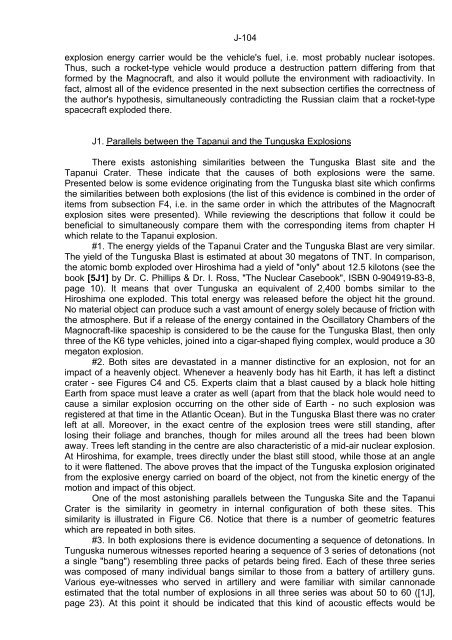
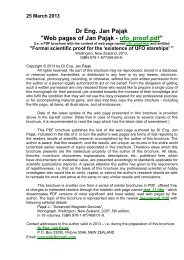


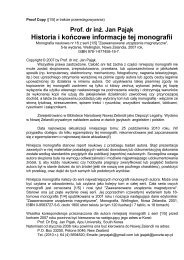
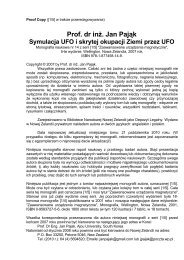
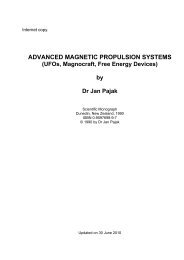
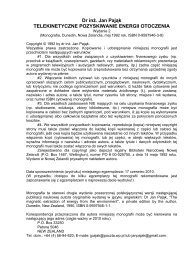
![[1/4p]: PDF - Totalizm](https://img.yumpu.com/45003232/1/184x260/1-4p-pdf-totalizm.jpg?quality=85)
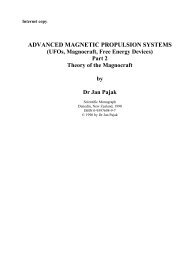
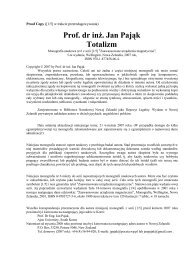
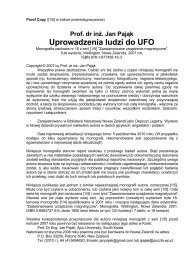
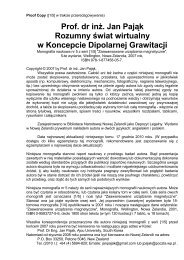
![[1/4p]: PDF - Totalizm](https://img.yumpu.com/39351336/1/184x260/1-4p-pdf-totalizm.jpg?quality=85)
